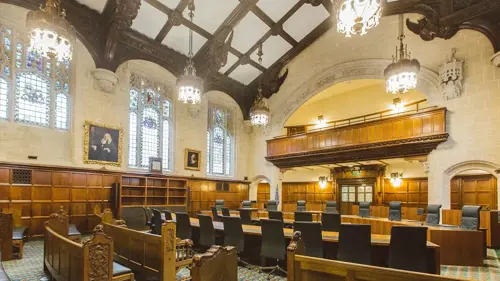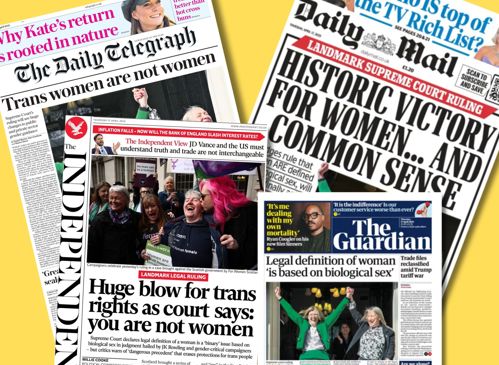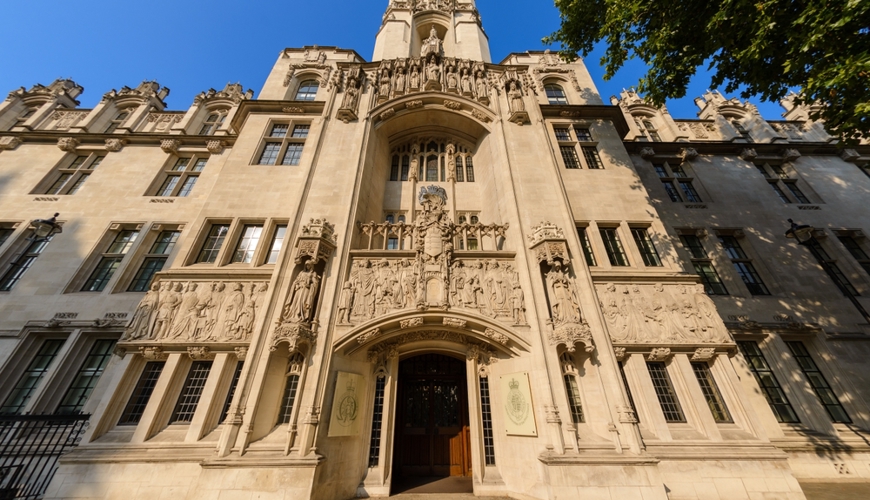What the Supreme Court's decision in For Women Scotland's appeal means

Front page news rarely does statutory interpretation make, writes Joshua King, but the case of For Women Scotland Ltd v The Scottish Ministers was different.
The decision, presented by Lord Hodge, ruled unanimously in favour of the appellants For Women Scotland (FWS) and found that the terms “woman” and “sex” in the Equality Act 2010 refer to biological woman and biological sex.
It marks the end of a long legal challenge led by FWS and other campaigners. But whilst the decision may settle the interpretation of language in the act, it opens a host of fresh legal questions around how the Equality Act continues to be implemented.
Background
The origin of the case is in the Gender Representation on Public Boards (Scotland) Act 2018 and associated guidance. The Act created targets for gender representation on public boards in Scotland. Initially, the act explicitly included in its definition of “women” people: (i) with the protected characteristic of gender reassignment; (ii) living as a woman; and (iii) proposing to undergo / undergoing / who have undergone a gender reassignment process. This was successful challenged by FWS in the Inner House in 2020, and subsequently the Scottish ministers issued new guidance which made reference to the definition of “woman” as in the 2010 Act. It also stated that a person with a Gender Recognition Certificate (GRC) recognising their gender as female was considered a woman for the purposes of the 2018 Act. This was the point challenged by FWS in this Supreme Court case.
Judgment
On Wednesday morning, the Supreme Court unanimously allowed the appeal, holding that the terms “man”, “woman” and “sex” in the 2010 Act refer to biological sex. Lord Hodge, Lady Rose and Lady Simler gave the joint judgement, with which the Justices Reed and Lloyd-Jones agreed. You can watch the full judgement at the end of this article.
Key Points
- Section 9(1) of The Gender Recognition Act 2004 established that trans people with a GRC are to be considered their “acquired” gender “for all purposes”. Section 9(3) states This can be disapplied by subsequent legislation, expressly or by implication.
- There is no provision in the Equality Act 2010 expressly disapplying Section 9(1) of the 2004 Act so the court carefully analysed provisions in the 2010 Act to determine if a definition of sex including acquired gender would make the provisions “incoherent or absurd”.
- Court found, “as a matter of ordinary language”, that the provisions could only refer to biological sex, and gives examples including pregnancy and maternity provisions which can “as a matter of biology” only refer to biological woman.
- Judgment found that an interpretation of sex as including acquired gender would cut across the definitions of “man” and “woman” incoherently, and would create two sub-groups within those sharing protected characteristic of gender reassignment: giving those trans people with a GRC greater rights than those without.
- Court held certified sex definition would weaken protections given to those with protected characteristics of sexual orientation by interfering with lesbian-only spaces or associations.
- Judgement raised confusion and impracticability of single sex spaces and services, citing these practical problems arising from a certified sex approach as an indication the interpretation is wrong.
- The Justices said it was also impractical to use a GRC to define whether a trans woman should be grated full protections because service providers are not supposed to ask to see the document.
- In judgment and in summary, court emphasised that this interpretation of the 2010 Act does not remove protection from trans people, with or without a GRC, and that they are protected from discrimination on the grounds of gender reassignment. Furthermore, a trans woman can claim sex discrimination because she is perceived to be a woman.
Legal Reaction
In reading out the ruling, Lord Hodge said the judgment should not be considered a "triumph" of one side over the other, and stressed – as the detailed judgment does – that the law offers protection against discrimination to trans people.
Scottish First Minister John Swinney said the Scottish Government accepted the ruling, and that “protecting the rights of all” will be the objective of its response.
Dr Michael Foran, lecturer in public law at the University of Glasgow whose writing was cited in the judgment , said the Supreme Court “resoundingly and unanimously” concluded the words man, woman and sex in the Equality Act are about biological and not acquired or certificated sex. Speaking to Radio 4’s PM show, he added: "This judgement has made it clear that it is lawful to exclude biological males from female only services, where those female only services are lawful under the Equality Act. Most public services like toilets will be."
Rosie Walker, head of litigation and dispute resolution at Edinburgh-headquartered firm Gilson Gray, instructed by intervenors Sex Matters in the appeal, said: “The ruling provides much-needed clarity over the definition of sex for the purposes of the Equality Act 2010, and the court recognised the valuable contribution made by Sex Matters to this important question of equality law.”

Sam Fowles, barrister and author writing in The Guardian, described the decision has having “limited reach”, but potentially broader implications socially. He said: “And what of the practical impacts of the decision? As of 2020, there were reportedly no trans women serving on public boards. Trans people make up around 0.44% of the over-16 population in Scotland.
“The chances of a cis woman losing a public board position to an equally qualified trans woman are vanishingly small. The 2018 act will still permit the appointment of a trans woman ahead of an equally qualified biological woman if the appointment can be justified on the basis of their “particular characteristics or situation”.
“In terms of the broader effects of the decision, there is some suggestion that this might affect women-only groups that wish to exclude trans women. It won’t. The law permitted such exclusions already. (Although it may be that some groups would feel more confident in using them after this decision.)”
Robin White, employment and discrimination barrister who also appeared on BBC Radio 4’s PM, explained that because excluding trans people is still only allowed if it is “a proportionate means of achieving a legitimate aim”, we are not likely to suddenly see security guards assessing people at the entrance to public toilets, for instance.
Elizabeth McGlone, managing partner at didlaw, described the implications as “huge”.
She said: “Employers will now have to consider their ‘inclusion’ policies in respect of ‘women’s’ facilities and ensure that they understand that woman, for the purposes of the Equality Act, means ‘biological woman’.”
Joshua Rozenberg KC, writing in his Substack newsletter, said: “What happens if a trans woman wishes to use a women-only provision, permitted where this is “proportionate”?
“If the person appears to be a woman then she is not likely to be stopped unless she is known or found to be trans.
“If she is excluded, she can no longer claim to have been discriminated against on the grounds of her sex. But has she suffered discrimination on the grounds of her gender reassignment? Only, it seems to me, if she is treated less favourably than someone who has not had gender reassignment.
“The thrust of the judgment — likely to be reflected in new guidance — is that trans women cannot insist on being treated in the same way as biological women, even if they have a gender recognition certificate. So the ruling is likely to make it harder for trans people to insist on being treated in exactly the same way as those who have not transitioned.”
Jonathan Mansfield, Employment Law partner at law firm Spencer West LLP, said: “This latest ruling highlights inconsistencies in sex based rights in employment and poses some practical issues for employers. Certain rights which are currently available related to sex such as equal pay will only be available based on biological sex.
"A trans woman, for example, will not have the right to bring an equal pay claim on the basis that she is paid less than a (biological) man. There is specific protection against discrimination for those who have undergone or propose to undergo gender re-assignment.
"However, this protection does not extend to all those who would be entitled to apply for a Gender Recognition Certificate where the requirements include a diagnosis or gender dysphoria and having lived in the acquired gender for at least two years among other requirements.”
Media Summary
Despite Lord Hodge’s encouragement for this ruling not to be considered a “triumph” of one side over another, and his acknowledgement of the emotional stakes, the media response was typically blunt. Headlines included “HISTORIC VICTORY FOR WOMEN… AND COMMON SENSE” (Daily Mail), “THE JOY OF SEX” (The Scottish Sun), “Huge blow for trans rights as court says: you are not women” (The Independent) and “Trans women are not women” (The Daily Telegraph).

These statements appear to contradict paragraph 2 of the judgement:
“It is not the role of the court to adjudicate on the arguments in the public domain on the meaning of gender or sex, nor is it to define the meaning of the word “woman” other than when it is used in the provisions of the EA 2010. It has a more limited role which does not involve making policy. The principal question which the court addresses on this appeal is the meaning of the words which Parliament has used in the EA 2010 in legislating to protect women and members of the trans community against discrimination. Our task is to see if those words can bear a coherent and predictable meaning within the EA 2010 consistently with the Gender Recognition Act 2004 (“the GRA 2004”).”
The discussion inside the newspapers and news sites, and indeed on radio and television, did move beyond the black and white winners and losers summation the court appeared at pains to avoid, but nonetheless the public was possibly ill-served by some of the coverage of this judgment.
What’s next?
This ruling may mark the end of one chapter, but it is in equal measure the start of another. New questions have already arisen about how this ruling is implemented in, for instance, single-sex spaces and services, women’s refuges, single-sex sport and other areas. Similarly, questions have been raised about the impact on employment and discrimination law.
The Court’s interpretation of statute begs the question of whether either the UK or Scottish Parliament will now consider amending legislation or passing new laws, but the consensus seems to be that neither government has the appetite for such change.







